Apple iPhone SE review (2020): Great phone, even better price
This cheap iPhone is as practical as it is powerful.
Every September, just like clockwork, Apple reveals a handful of new high-end phones. If this year’s rumors hold true — and if the company’s plans don’t get delayed — its 2020 flagships will come with super-fast new processors, LiDAR sensors for better depth detection and new designs inspired by the iPad Pro. They will cost a lot of money, and they’ll probably be great. I mention this because, despite everything the new devices will bring to the table, the new iPhone SE might be the most important phone Apple releases this year.
It’s not just because the iPhone SE is cheap, though it certainly is: The base model costs only $399. No, what makes the SE so valuable is that it doesn’t act like a $399 phone. The iPhone SE isn’t just a good deal — it’s a big deal. For people clinging to ancient phones because new ones are too large, too expensive or too gimmicky, the iPhone SE is the right phone at the right time at the right price.
Key specs
| Apple iPhone SE (2020) |
|---|---|
Processor | A13 Bionic |
Internal storage | 64GB, 128GB and 256GB |
Main Display | 4.7-inch Retina HD LCD display |
Display resolution | 1,334x750 (16:9) |
Rear cameras | 12MP f/1.8 camera with HDR and optical image stabilization |
Front-facing camera | 7MP f/2.2 camera |
OS | iOS 13.4 |
Charging | Lightning, supports 18W+ fast charging and Qi wireless charging |
Dimensions | 138.4 x 67.3 x 7.3 mm |
Weight | 148g |
Fingerprint sensor | Yes, in home button |
Waterproofing | IP67 |
NFC | Yes |
Headphone jack | No |
Configurations
If you're thinking about picking up an iPhone SE, you have a few decisions to make. First up: What color you're going to show off for the next few years. The iPhone SE comes in black, white and PRODUCT(RED) finishes, and it's worth noting all of these models have black fronts. (Some geeky corners of the internet have been clamoring for a black-and-white iPhone for years — if that's you, this is your time.)
The more important decision is how much storage you'll need. As I mentioned, the base iPhone SE costs $399, which nets you 64GB of room to play with. That'll be enough for plenty of people, but the safest bet is to shell out an extra $50 for the 128GB model. There's also a 256GB model for $550, which might make more sense if you shoot loads of videos or have a massive media collection.
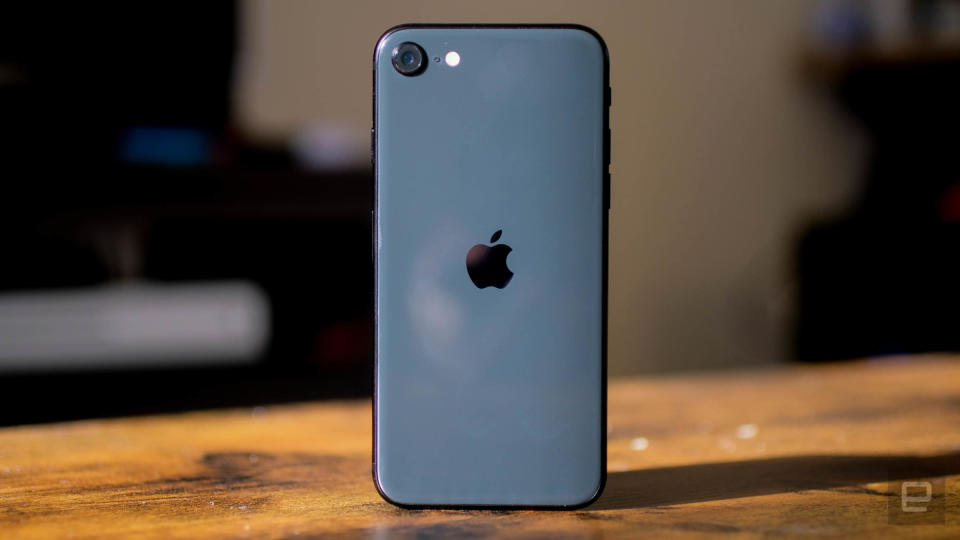
What’s old is new again
In case you hadn’t noticed, Apple is no stranger to budget gadget territory. Apple’s first budget iPhone, the 5c, was released in 2015 to pretty tepid sales. But the original iPhone SE — which packed the guts of an iPhone 6s into the body of a 5s — quickly became a fan-favorite. Since then, the iPhone XR, iPhone 11 and the company’s low-cost iPads have become some of Apple’s biggest hits. In other words, people like expensive iOS devices, but they love cheap ones.
It might be a little reductive, but the easiest way to think about the iPhone SE is that it squeezes a lot of what makes the iPhone 11 so potent into the body of an iPhone 8. When it comes to performance, that's great news, but I just have to say it: The iPhone SE looks dated. This design hasn't changed in three years. Since then, we've seen mid-range Android smartphones adopt edge-to-edge displays and sprout multiple rear cameras — the SE can't help but look basic by comparison. That's due in large part to its screen: a 4.7-inch Retina display that runs at 1,334x750, and it's basically the same display we got three years ago.
Now, there's nothing necessarily wrong with the screen, especially considering the price. It's plenty bright for outdoor use, and colors look decently rich thanks to wide color gamut support. There's a TrueTone sensor to measure your ambient light and tune the screen's color temperature to look natural no matter where you're sitting. And even though it runs at a lower resolution than every other smartphone Apple makes, its smaller screen means you're looking at the same pixel density as the iPhone 11 — you'll never see individual pixels unless you press your nose right up to the glass.
I'm not going to sit here and tell you I'm in love with this screen — it's easily the least impressive part of this phone. Even so, this display is perfectly fine for what it is. The only real question is whether it's big enough for you. Frankly, it isn't for me: My eyes aren’t great, so I gravitate toward phones with bigger screens. And my thumbs are sort of fat, so typing on this display took a lot longer to get used to than I had hoped. If some of that rings true for you, too, the iPhone SE may not be the right fit.
Of course, there are people for whom the opposite might be true. I've met a surprising number of people over the years who found the original iPhone SE design — the one it shared with the iPhone 5s — ideal. For them, this newer version might actually feel a little too big. What can I say? It all boils down to taste.
If you are a fan of this smaller design, though, you'll reap a few unexpected rewards. For one, if you ever break this phone, you'll spend less repairing it than you would with a more premium iPhone. Apple says it's going to charge $129 for iPhone SE screen replacements — that's $20 less than the same procedure for an iPhone 8 and $70 less than to replace an iPhone 11's screen. The same goes for battery replacements without AppleCare. If your SE’s battery eventually tanks, it’ll cost $49 to swap for a new one — for Apple’s premium phones, it’s $69. It's easy to get hung up on how little you'll spend on an iPhone SE, but it's important to know that it won't cost a ton to keep it running if something goes wrong.
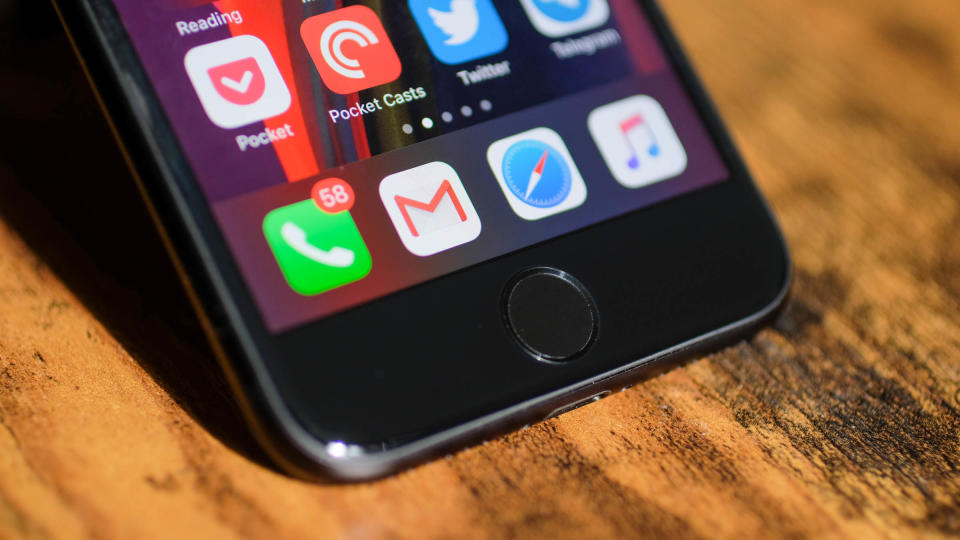
Obviously, there's more to this phone than just its screen. That huge bit of bezel at the bottom has a solid-state home button with a proper Touch ID sensor, and I have to say I forgot how good these things were. Setting it up takes moments at most, it reads fingerprints almost instantly and — maybe most important these days — it still lets you unlock the phone while wearing a mask. This throwback iPhone body also rates IP67 for water and dust resistance, so it can sit in a meter of water for up to 30 minutes before you need to properly freak out. (For what it's worth, this kind of life-proofing is rare among the iPhone SE's Android-powered competitors.)
Apple made some important under-the-hood tweaks here, too. The SE is the company's first small iPhone to support dual SIM use with an eSIM, making it a great international travel companion. (You know, when we can finally start doing that again.) Apple also added support for gigabit LTE and WiFi 6 here — the latter is especially good news if you already splurged on a compatible router.
Ultimately, the iPhone SE isn't the prettiest phone out there, but by now you probably already know if you can live with a screen this size. If you can, well, you're in luck: Few companies even bother to make small smartphones anymore, and great small smartphones are even rarer. The iPhone SE is definitely one of them.
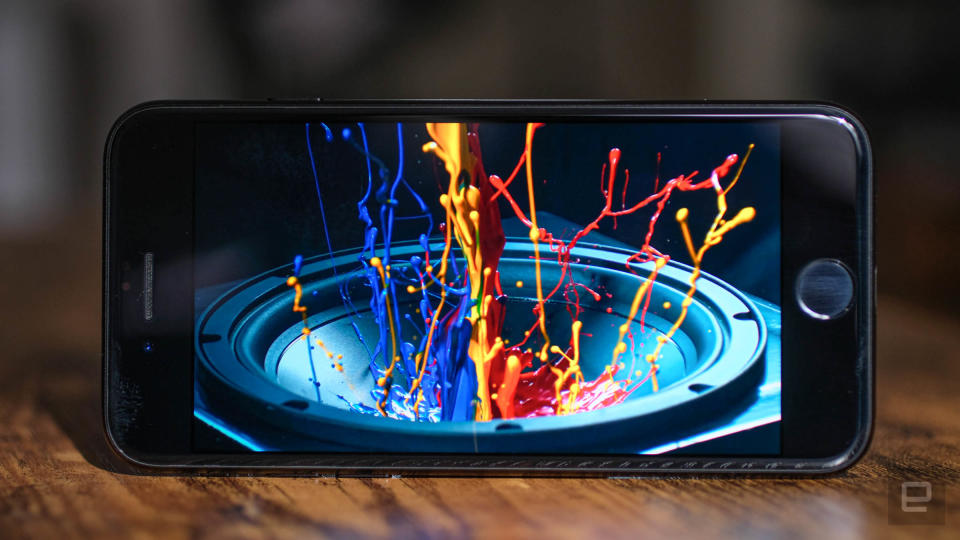
In use
If you're looking to spend about $400 or $500 on a smartphone and are open to using Android and iOS, you're spoiled for choice. There's a version of Samsung's Galaxy A51 with four rear cameras and 5G support for $499. OnePlus's very good OnePlus 7T packs a super-smooth 90Hz display and a great customized Android build. Hell, TCL will soon release a trio of seemingly solid phones, one of which is 5G, and all under $500. You get where I'm going here. The thing to remember is none of those smartphones — or any other in this price range — uses the highest-end processors available to them. Except for the iPhone SE.
Apple used its A13 Bionic chipset, which is the very same slice of silicon powering the company's most expensive smartphones. Needless to say, you're not going to be left wanting for power. If anything, squeezing a processor package this powerful into a $400 phone feels like, well, the best kind of overkill. If you want more detail about the architecture of the A13 Bionic and how it compares to older Apple devices, you should check out our iPhone 11 Pro and Pro Max review. Retreading that ground seems unnecessary here — all you really need to know is that the iPhone SE can handle damn-near anything.
I've played graphically intense games, I've jumped between apps like a crazy person, I've converted 4K videos to 1080p. Put another way, I've done my best to try to throw this thing for a loop, but the iPhone SE just shrugged everything off. Again: This is $1,000 performance in a $400 body — it’s basically the polar opposite of something like Motorola's Razr. The SE is no style, all substance.
iPhone SE | iPhone 11 Pro | OnePlus 8 Pro | |
|---|---|---|---|
Geekbench 5 CPU (Single-Core) | 1330 | 1332 | 887 |
Geekbench 5 CPU (Multi-Core) | 3215 | 3417 | 3241 |
Geekbench 5 Compute (Metal and OpenCL) | 6286 | 6348 | 2937 |
The A13 Bionic also gives the iPhone SE a lot of performance headroom for iOS to grow into. And you'll probably need it. Remember the original iPhone SE? It received the iOS 13 update last year. That means it got four years of software updates — some admittedly better than others. I like Samsung plenty, but its long-standing policy is to offer just two years of major Android software updates for its phones. Google's Pixels are a little better since they get "at least" three years worth of updates, but still: Apple's track record is the best of the lot.
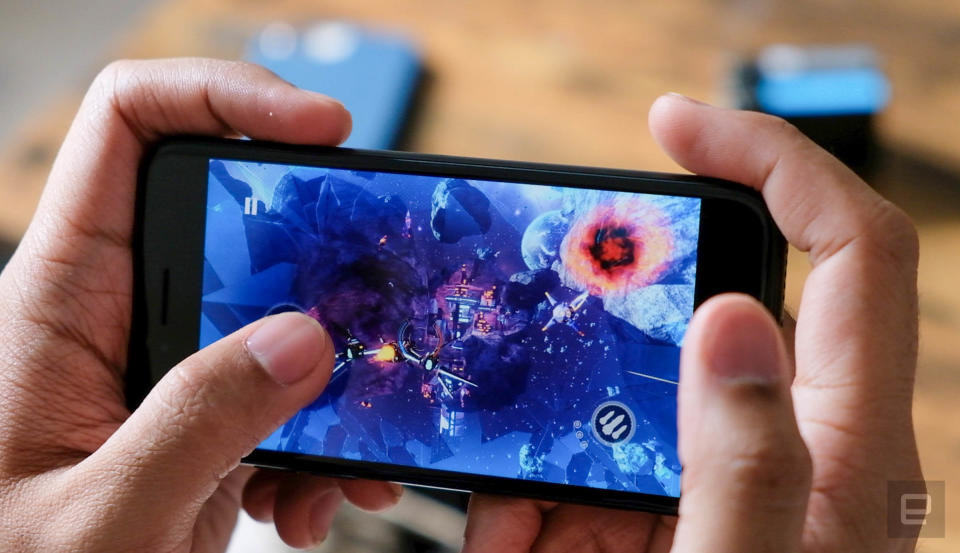
So, yes, in terms of overall performance, the iPhone SE is an untouchable bargain. I do, however, wish it had a slightly better battery. I've been using the SE as my daily driver for the past few days, and with pretty consistent use, it tends to last between 11 and 12 hours on a single charge. That's without much coddling, bear in mind. If you aren't glued to the phone all the time, and you're judicious about what apps you use, you could reasonably have enough power to last until the following morning. Of course, the flip side is also true: On days I used the phone heavily for games and camera tests, the norm typically fell between eight and 10 hours.
There’s one more thing we need to dig into: 5G. The iPhone SE packs support for gigabit LTE, and I saw solid download speeds on T-Mobile’s network here in Brooklyn, but 2020 is the year we’re going to see mid-range phones with 5G support really flourish thanks to inexpensive chipsets like Qualcomm’s Snapdragon 765. I’ve talked a lot about how the iPhone SE should last people a long time because of its low repair costs and Apple’s huge window for device support, and those are definitely big deals for people who mainly want a cheap, reliable phone. Still, this thing is never magically going to sprout a 5G radio and tap into new, super-fast wireless networks.
In other words, if you buy one, you’re basically saying you’re OK to skip out on that progress for a while. I suspect most people who’d consider an iPhone SE won’t be too concerned — it’s not like existing LTE networks are going to get worse anytime soon — but it’s still worth keeping in mind.

A surprising camera
Going into this, the iPhone SE’s camera situation was the only thing I was really concerned about. There are no fun wide-angle or telephoto sensors here, so the SE has — on paper, at least — one of the less flexible camera setups you’ll find on a $400 phone. Apple has been really cagey about what sensor it used here too, though we eventually got someone from Apple Hong Kong to confirm it isn’t same sensor found in the iPhone 11. What we do know is that this single 12-megapixel camera has an f/1.8 aperture, a six-element lens and optical image stabilization.
I spent most of my time testing the iPhone SE against the iPhone 11 and my favorite Android phone of all time, Google's Pixel 3a XL. The choice seemed especially apt since the Pixel 3a and iPhone SE have similar philosophical approaches to photography — both phones have just one rear camera, and they capture images that get intelligently processed to make them prettier.To begin with, I was sure I'd prefer the Pixel's photos since Google’s computational photography chops are downright wild, but for the most part, I was wrong. The iPhone SE frequently produced pleasing pictures with warmer, more appealing colors and less noise in dark spots.
In fact, most of the time, I couldn't really tell the difference between iPhone SE photos and iPhone 11 photos because the post-processing is similar — if not identical — between the two. Every once in a while, I'd notice a few fine details in a picture I took with the iPhone 11 that weren't as distinct in the same photo taken with an iPhone SE. Still, the fact that I had to spend time scrutinizing these pictures to spot the differences kind of says it all: The iPhone SE's main camera punches way above its weight.
The 7MP selfie camera produces some decent selfies, too, and you can use either of the iPhone SE's cameras to shoot some handsome bokeh-filled portraits. That said, this iPhone’s portrait mode doesn't work at all unless you're pointing the main camera at a person — this limitation is bound to be a bummer for pet owners or folks who are proud of their beautiful sourdough loaves, but I wouldn’t call it a dealbreaker.
If video is more your concern, the handful of 4K video clips I've shot look pretty good. None of them are going to get the nod during award season, but they're more than fine considering the price. The only real knock against the iPhone SE's camera experience is that there's no dedicated Night mode. Apple wouldn't really explain why, but that's going to remain exclusive to high-end iPhones for now. It’s a good thing that low-light performance, here, is still pretty respectable — fine details tend to get fuzzed out thanks to the camera’s Smart HDR processing, but the colors and exposure didn’t leave me with much to complain about.
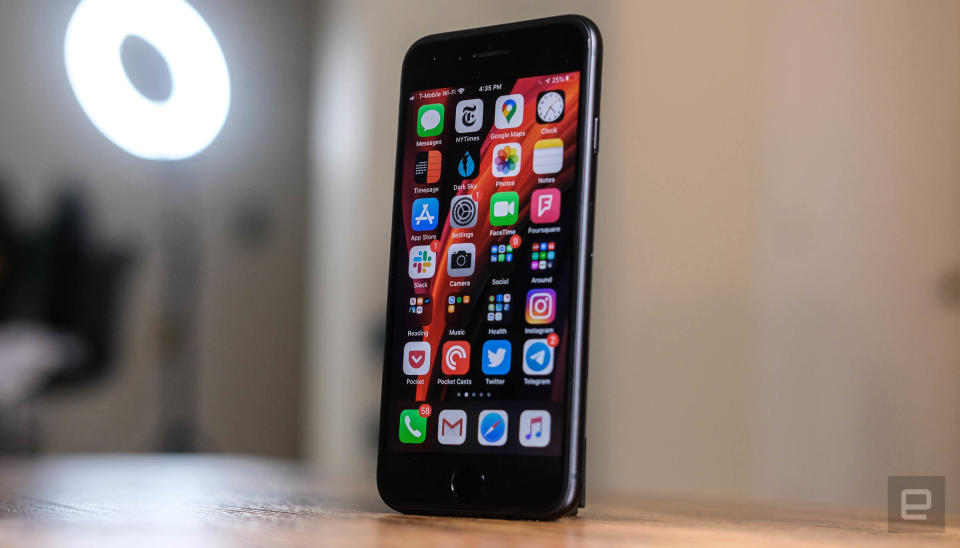
Wrap-up
Whenever I turn in an iPhone review, my editor usually wants to push me out a window because it’s 4,000 words long. This time, though, I think the iPhone SE speaks for itself. It is the best budget smartphone out there. That's really saying something, considering how strong its competition has gotten — there are handfuls of devices that cost the same with bigger screens and better batteries and plenty of cameras. It goes without saying that this very specific version of the iPhone won’t make sense for some people, and that includes me. For fans of small phones, though, or for anyone who wants a phone that’s as practical as it is powerful, the iPhone SE is as good as it gets.

